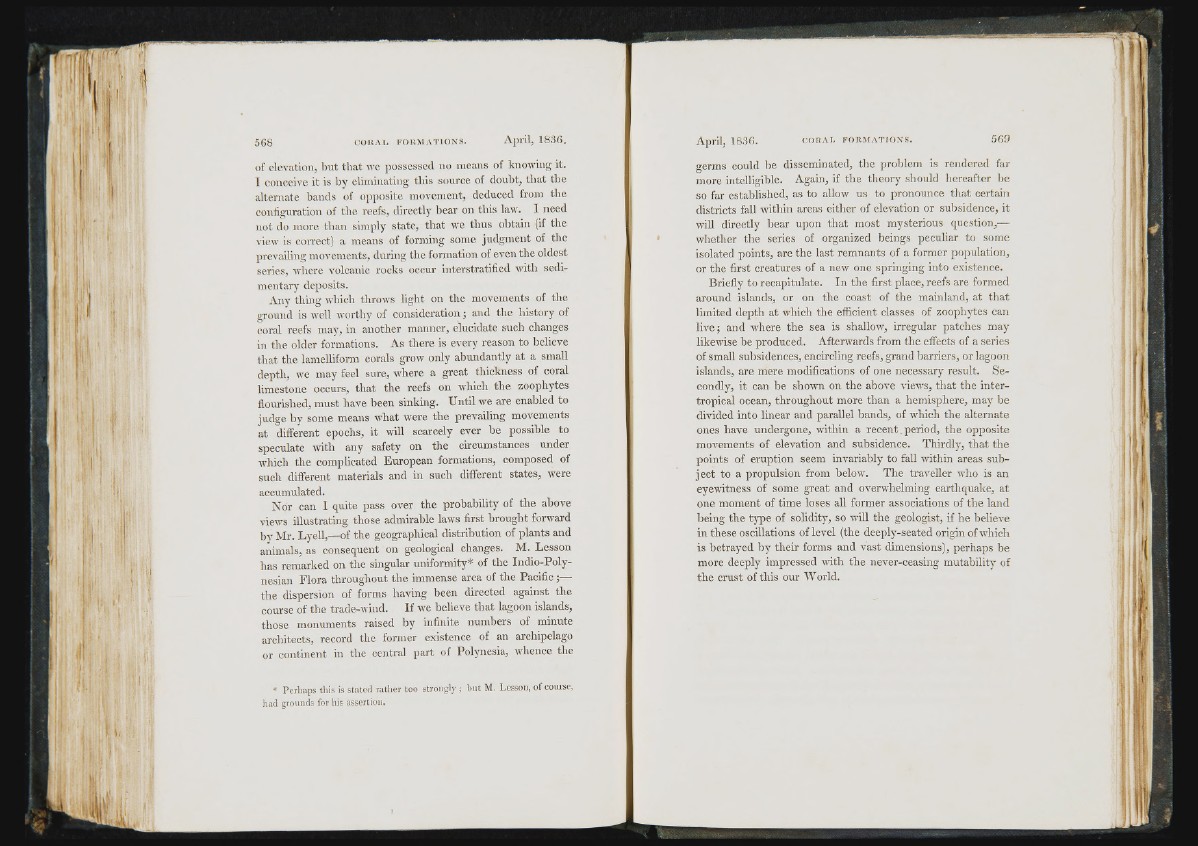
- I f Hi I
m í : i
*T H '
r ri
! I
568 OOl i A L F O KM A T 1 OXS . A j i r i t , 1 8 3 6 .
of elevation, but that we jiossossed no means of knowing it.
I conceive it is by eliminating this source of doubt, that the
alternate bands of opposite movement, deduced from the
coutiguratiou of the reefs, directly bear on this law. I need
not do more than simply state, that we thus obtain (if the
view is correct) a means of forming some judgment of the
prevailing movements, during the formation of even the oldest
series, where volcanic rocks occur iuterstratified with sedimentary
deposits.
Any thing which throws light on the movements of the
ground is well worthy of consideration; and the history of
coral reefs may, in another manner, elucidate such changes
in the older formations. As there is every reason to believe
that the lamelliform corals grow only abundantly at a small
depth, we may feel sure, where a great thickness of coral
limestone occurs, that the reefs on which the zoophytes
flourished, must have been sinking. Until we are enabled to
judge by some means what were the prevailing movements
at different epochs, it will scarcely ever be possible to
speculate with any safety on the circumstances under
which the complicated European formations, composed of
such different materials and in such different states, were
accumulated.
Nor can I quite pass over the probability of the above
views illustrating those admirable laws first brought forward
by Mr. Lyell,—of the geographical distribution of plants and
animals, as consequent on geological changes. M. Lesson
has remarked on the singular uniformity* of the Indio-Poly-
nesian Flora throughout the immense area of the Pacific ;—
the dispersion of forms having been directed against the
course of the trade-wiud. If we believe that lagoon islands,
those monuments raised by infinite numbers of minute
architects, record the former existence of an archipelago
or continent in the central part of Polynesia, whence the
« P e rh a p s th is is s ta te d r a tlie r to o stro n g ly ; b u t M. L e s so n , o f co u rse,
h a d g ro u n d s for his a sse rtio n .
April, 18.36. C O U A I . F O l lM A T / O N ' S . 56!)
germs could be disseminated, the problem is rendered far
more intelligible. Again, if the theory should hereafter be
so far established, as to allow us to pronounce that certain
districts fall within areas either of elevation or sultsidence, it
will directly bear upon that most mysterious question,—
whether the series of organized beings peculiar to some
isolated points, are the last remnants of a former population,
or the first creatures of a new one springing into existence.
Briefly to recapitulate. In the first place, reefs are formed
around islands, or on the coast of the mainland, at that
limited depth at which the efficient classes of zoophytes can
live; and where the sea is shallow, irregular patches may
likewise be produced. Afterwards from the effects of a series
of small subsidences, encircling reefs, grand barriers, or lagoon
islands, are mere modifications of one necessary result. Secondly,
it can be shown on the above views, that the intertropical
ocean, throughout more than a hemisphere, may be
divided into linear and parallel hands, of which the alternate
ones have undergone, within a recent, period, the opposite
movements of elevation and subsidence. Thirdly, that the
points of eruption seem invariably to fall within areas subject
to a propulsion from below. The traveller who is an
eyewitness of some great and overwhelming earthquake, at
one moment of time loses all former associations of the land
being the type of solidity, so will the geologist, if he believe
in these oscillations of level (the deeply-seated origin of which
is betrayed hy their forms and vast dimensions), perhaps be
more deeply impressed with the never-ceasing mutability of
the crust of this our World.
i T
ii -
r . .
' ri
1 j